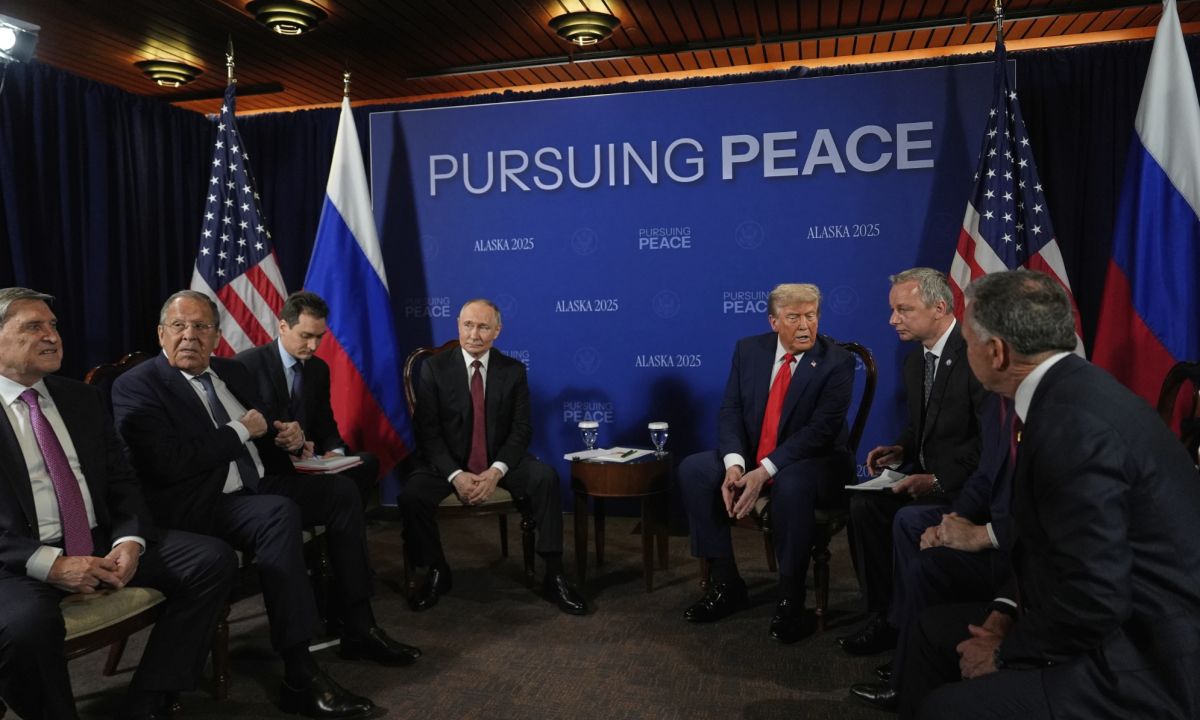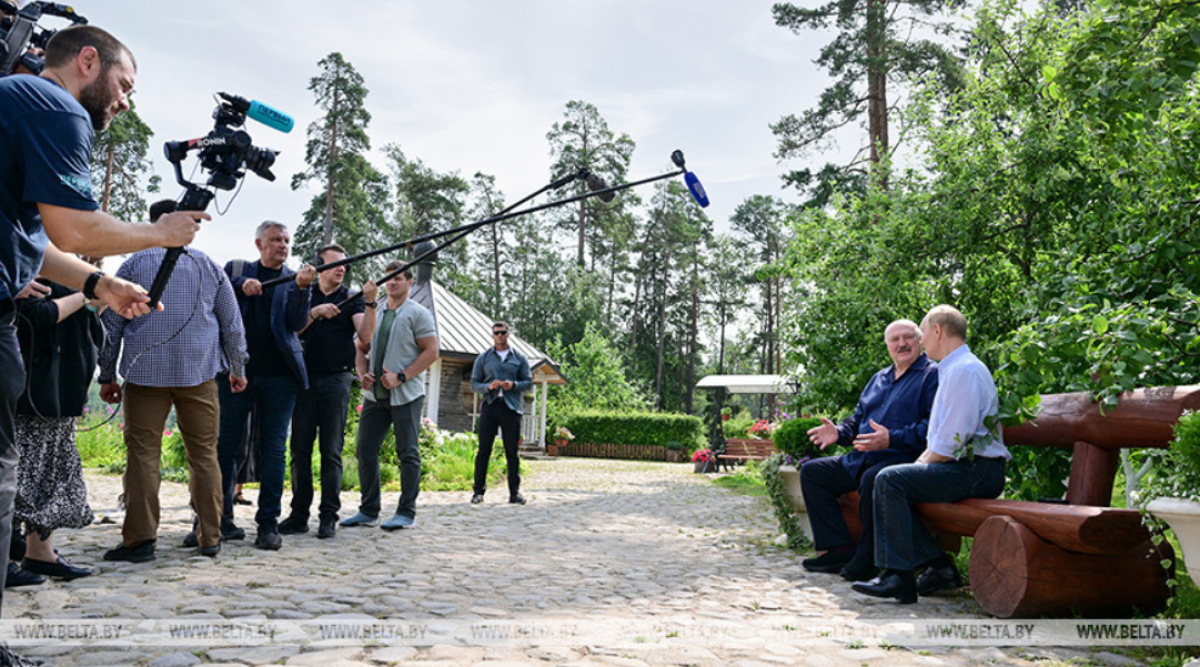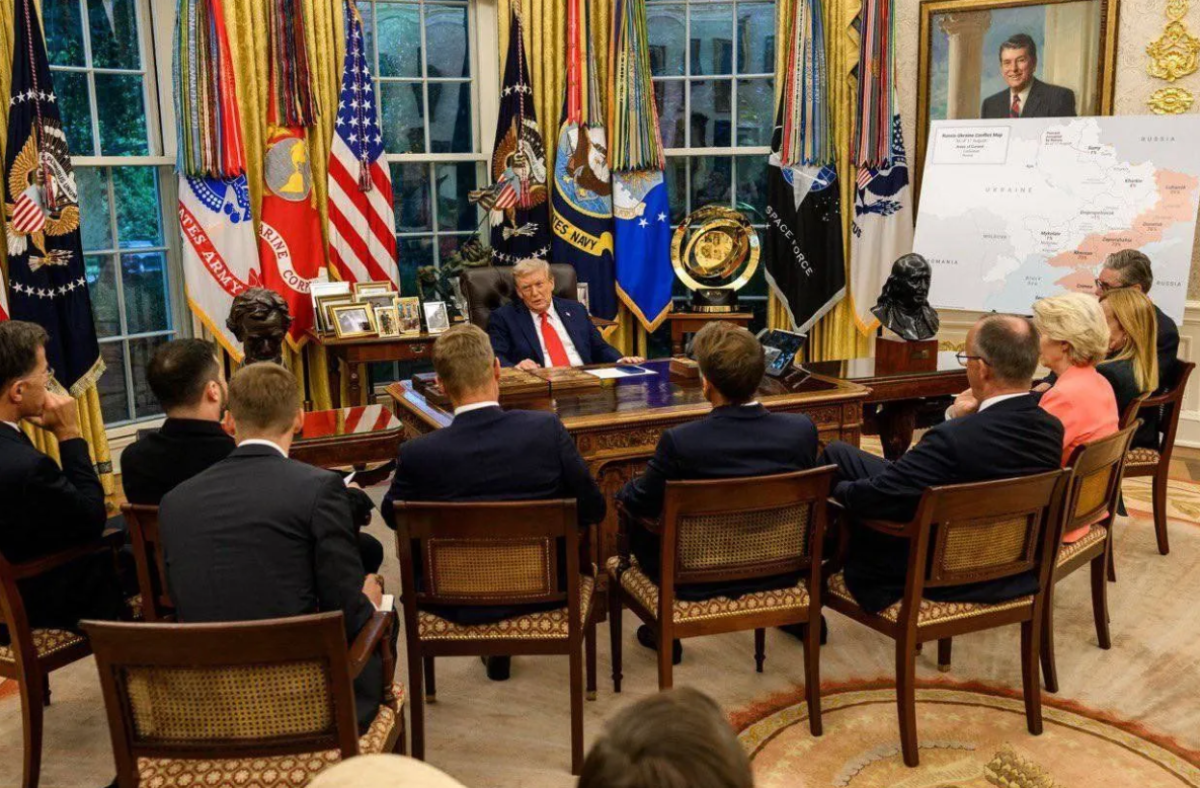
Anchorage/Washington, D.C.: Can Trump force Europeans to make peace?
One of the central problems facing the hegemon is that the US has lost its escalation dominance in the nuclear arms race. The events in Alaska were therefore not just about Ukraine, but about the two largest nuclear powers in the world attempting to rebuild trust and “slow down a runaway train in a mad high-speed race toward nuclear confrontation.” The Europeans (and their mentors in the British-American Deep State) simply refuse to accept that this train has left the station. Hopefully, they can still be slowed down.
Anchorage, Alaska
The American and Russian presidents met in person for the first time since 2022. It is clear that both want something – Russia wants peace, the Anglo-Saxons want a respite. There are good reasons for this.
Russia is seeking a new security architecture in Europe that takes Russian interests into account.
Donald Trump personally wants the dying in Europe to stop for the time being. The real reason for this is the obvious inability of the US to cope with its geopolitical challenges. The Americans are unable to defeat the Houthis, yet they are actively involved in wars they are losing in the Middle East and Ukraine, and are preparing for a major showdown with the Chinese. That is too much to handle at once. The Trump team therefore urgently needs to take one iron out of the fire.
A brief look back
Withdrawal from disarmament treaties
Under Donald Trump, the US has withdrawn from two important disarmament and arms control treaties.
The INF Treaty (Intermediate-Range Nuclear Forces Treaty of 1987 between the US and the USSR) banned land-based ballistic missiles and cruise missiles with ranges between 500 and 5,500 km. The US announced its withdrawal on February 1, 2019.
The Open Skies Treaty, signed in 1992 and in force since 2002 with over 30 participating states, allowed mutual unarmed surveillance flights to create transparency about military activities. The US terminated the treaty under Trump-1.0. The withdrawal took effect on November 22, 2020.
Then there is the New START Treaty (Strategic Arms Reduction Treaty) between the US and Russia. This came into force in 2011 and was extended by both sides in 2021 for five years, until February 5, 2026. The treaty therefore remains formally valid. However, Russia suspended its participation on February 21, 2023, which means no more inspections, no data transmission, and no exchanges in the bilateral consultative commission. At the same time, however, Russia emphasized that it would continue to comply with the quantitative limits.
Nuclear arms escalation by the US and Europe
Now the US is currently in the process of relocating nuclear bombs to European sites. The Trump administration has also announced that it will deploy intermediate-range ballistic missiles (IRBMs) and other long-range weapons in Europe starting in 2026, with Germany being the first “host country” for these systems. The joint communiqué issued by Germany and the US (July 10, 2024) states that, as part of plans for permanent deployment, long-range weapon systems belonging to the US Multi-Domain Task Force are to be stationed in Germany on a temporary basis from 2026. These include SM-6s, Tomahawks, and hypersonic weapons currently under development.
Now Russia and its allies have had enough
These escalatory steps will no longer be tolerated.
On August 1, 2025, the presidents of Belarus and Russia met.

On this occasion, Lukashenko stated that the “Oreshnik” systems currently in series production in Russia (also known by their NATO designation SS-X-34, mobile solid-fuel hypersonic missiles with a range of approx. 5,000 km) will soon be deployed at sites in Belarus. The infrastructure is already under construction there.
In the same conversation, President Putin announced a statement by the Russian Foreign Ministry, which was then published on August 4, 2025. In it, it stated, among other things, that following the US withdrawal from the INF Treaty, Russia had voluntarily imposed unilateral self-restrictions that preclude the deployment of ground-based missiles with INF range, unless similar missile weapons produced in the US appear in the relevant regions of the world. Now, however, it had to conclude that the Russian initiatives had not been reciprocated. On the contrary, not only had the US produced such systems, but the Pentagon was also training and deploying special forces and commandos in the relevant regions to enable the forward deployment and use of such weapons.
In view of this development, the Russian Foreign Ministry issued the following statement:
"Since our repeated warnings in this regard have been ignored and the situation is developing towards the actual deployment of US-made ground-based INF missiles in Europe and the Asia-Pacific region, the Russian Foreign Ministry must declare that the conditions for maintaining a unilateral moratorium on the deployment of similar weapons no longer exist. The Ministry is authorised to declare that the Russian Federation no longer feels bound by the self-imposed restrictions previously agreed upon."
Statement by the Russian Foreign Ministry
In light of this, the US changed its strategy.
Two days after this statement by the Russian Foreign Ministry, US emissary Steve Witkoff arrived in Moscow on August 6, 2025, and urgently requested that a meeting between Presidents Trump and Putin be arranged.

The Russian side agreed to such a meeting, but insisted that it must take place on US soil. As is well known, a summit meeting between Trump and Putin was then actually organized for August 15, 2025, in Anchorage, Alaska, at which the Trump team made a clear U-turn: away from the slogan “first a ceasefire, then peace negotiations” to the slogan “only in a comprehensive peace can the weapons fall silent.”
"It was determined by all that the best way to end the horrific war between Russia and Ukraine is to go directly to a Peace Agreement, which would end the war, and not a mere Ceasefire Agreement, which often times do not hold up."
Trump on Truth Social
This led to hysterical horror among the European warmongers.
Problem Europe
After Trump left them waiting at the door, representatives of the coalition of the willing (Merz, Starmer, Macron, Meloni), Finland's Stubb, NATO Secretary General Rutte, and Ms. von der Leyen for the EU were allowed into the Oval Office on August 18, 2025, to negotiate a peace they don't even want. And yes, we have practically forgotten about Vlodomir Selenski, because he is no longer important. He will be pushed around by the Europeans like a pawn on a chessboard until he is no longer needed. In this last meeting with Trump, Selenski behaved very nicely.

The published photos of this meeting reveal a clear power imbalance: Trump sits behind the Resolute Desk, while the European leaders and Zelensky are seated on chairs opposite him. Some observers interpreted this arrangement as symbolic of the hierarchical structure of the talks, with Trump emerging as the dominant figure.

Ms. von der Leyen had no mandate for the negotiations. She does not speak for the EU, but for the warmongers among the member states. Messrs. Fico and Orban are being deliberately ignored. But Ms. von der Leyen does not seem to need a mandate—she is the ruler of Europe, or at least she thinks so.
The statements made by the ladies and gentlemen were practically identical. They all spoke politely about the poor children who were allegedly abducted by the evil Russians. There is no truth to this story, even though President Putin and Ms. Lvova-Belova are being “wanted” by the ICC for precisely this reason. In reality, the Russians rescued orphaned children from the war zones of Ukraine.
The credibility of this international “legal institution” has been severely undermined by the West's efforts to wage a “legal battle” against Russia, a member of the European Parliament (MEP) has said. Luxembourg's Fernand Kartheiser made the comments after Switzerland offered to host peace talks with Ukraine and suggested that Russian President Vladimir Putin should be granted immunity from an arrest warrant issued by the International Criminal Court (ICC).
“I don't think it can continue to be claimed that there has been a systematic abduction of Ukrainian children to Russia. I therefore believe that the credibility of the ICC arrest warrant is also questionable.”
Luxembourg's Fernand Kartheiser (Member of the European Parliament)
It became clear within minutes that the Europeans do not want peace: unlike the US, they want a so-called ceasefire, not peace. The ladies and gentlemen have Minsk III in mind: a ceasefire, NATO troops in Ukraine, so that they then have time to rearm Ukraine and provoke a new conflict with the Russians at the appropriate moment, allowing the game to continue. This proposal will not succeed, either with the Russians or, in all likelihood, with the Americans.
What has Trump learned since January?
President Trump has been playing his carrot-and-stick strategy since January. What appears to outsiders to be chaos has, however, yielded some insights. The following countries can be put under pressure and will cave in: the EU, Switzerland and, to a certain extent, the UK. These countries reliably cave in and behave exactly as they should – like colonies. The situation is quite different with the big players from the Global South: China, Russia, India, and Brazil not only withstood the pressure, but the pressure exerted had negative consequences for the US. For example, it brought India and China, which have their differences, closer together. In our view, these insights are important in the context of the US's further behavior toward Ukraine.
The delegation that met with Trump was also obsequious and subservient toward Trump.
Will Europeans eventually realize that their wishful thinking cannot be reconciled with reality?
The conditions demanded by Europeans are deal breakers. Russia's conditions have changed only marginally since the negotiations in Istanbul in 2022, which were thwarted by Boris Johnson. No foreign troops in Ukraine and complete neutrality are basic prerequisites for the Russians to achieve peace. Furthermore, President Putin cannot under any circumstances relinquish control over Russian territories. This rules out territorial concessions regarding Crimea, Zaporizhzhia, Kherson, Luhansk, and Donetsk. The Europeans know this too.
It is probably the first time in history that the losers of a war would determine the terms, according to the Europeans' plan. That will not happen.
If one wonders why there is no longer any war reporting in Western media, the answer is simple: the Russians are systematically advancing and Ukrainian resistance is growing weaker. There is nothing to report that would lift the bellicose European spirit. The problem for Team Trump is that the Russians will achieve their military objectives in any case, whether peace is achieved through negotiations or surrender. If Trump wants to keep his election promise – and yes, he is flirting with the Nobel Peace Prize – he must successfully put pressure on the Europeans.
The Europeans are unwilling or unable to recognize that the US has changed its geostrategic tactics. The focus of its interests is no longer in Western Europe, which has long served as a springboard for conflict with Russia, but in the Middle East and China. We do not believe that the US has abandoned its long-term goal of “splitting Russia”; rather, it has merely postponed it.
The disaster scenario for those in power in Europe is the outbreak of peace. The oppressed European peoples have been harassed by their masters since Covid, first with fear and now with hatred of Russia. Everything has been subordinated to these two goals, which have made a few people filthy rich. The misallocation of resources over the past five years has been astronomical. If the state of emergency cannot be maintained, the people will eventually realize the horror that has been created by their leaders. This could lead to nothing less than unrest.
So the current European rulers must maintain a state of panic in their countries and are therefore dependent on war.
Trump's completely erratic behavior could now become a trump card for the US: no one knows what rabbit Donald will pull out of his hat to get the Europeans back on track – not even himself.
The Council on Foreign Affairs accurately characterizes the back-and-forth between Europeans and the US as follows:
“The Ukraine-Russia conflict and the back-and-forth between the United States and Europe on this is not dissimilar from how the U.S.-EU trade relations have gone. There are always high expectations, and then the Europeans’ expectations are dashed by the Americans… Then when they meet again, having avoided the worst outcomes, they come to some sort of agreement. It’s better than they feared, but it’s always worse than the status quo. But as the saying goes, the Europeans live to fight another day.”
CFR expert Matthias Matthijs
Conclusion
Russia will win this war, either at the negotiating table or on the battlefield. However, an agreement would also be in Russia's interest for human, economic, and geopolitical reasons.
The Trump team currently seems to want peace in Ukraine. There are two main reasons for this: First, after temporarily losing its nuclear escalation dominance, the US needs to consolidate its forces, and the troubles in the Middle East and preparations for the conflict with China seem more important to it. It needs to pull a rabbit out of the hat.
The European rulers need war, otherwise they will lose their jobs, because they have steered their countries into the abyss and will only survive as long as they can maintain a state of emergency. In doing so, they are supported by their mentors in the British-American Deep State, who should never be underestimated.
But as President Putin said more than six months ago:
“I assure you, Trump will restore order quite quickly with his character and persistence. And you will see, soon they will all stand before the master and wag their tails gently.”
Vladimir Putin
Nevertheless, Mr. Trump still has a lot of hard work ahead of him.
«Anchorage/Washington, D.C.: Can Trump force Europeans to make peace?»